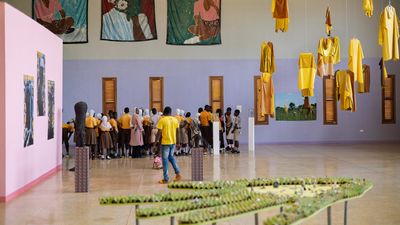Venturing Outside of Accra, Finding a Crossroads of Arts and Culture in Northern Ghana
The capital city may be the hotspot of year end celebrations but the artists in Tamale make the northern city its own vibrant place.
Ghanaian artist Ibrahim Mahama recently rose to number six in Art Review’s Power 100 list. Ranking high within the respected art publication is no small feat, yet it came as no surprise to anyone paying attention to the formidable work achieved by Mahama through his art, and his commitment to supporting artists in his native city of Tamale.
Since 2019, Mahama has run the Savannah Center for Contemporary Art (SCCA), Red Clay studio, and Nkrumah Voli-ni, three enormous spaces where culture, community and experimentation intersect. “For us, art isn’t so much about making the work in itself,” as Mahama said in an interview with YouTuber Caleb Kudah. “The world is a mess, we have to find ways to redistribute and disseminate.” This idea, and the institutions he is spearheading, are manifestations of a fluid movement of artists and thinkers known as blaxTARLINES KUMASI, who are challenging the narratives that have shaped Ghanaian contemporary art over time.
A DIY ethic
For decades, the lack of local support, and a strong dependency on foreign platforms, limited what was considered valid art. Since the early 2000s, Kwame Nkrumah University of Science and Technology professor and artist karî’kachä seid’ou has been offering radical ideas, and mentoring a new wave of artists to help change this.
Dr. Bernard Akoi-Jackson attributes the development of venues dedicated to the arts to “the revolutionizing conditions that have emerged from the blaxTARLINES KUMASI collective,” allowing “a great deal of emancipation and daring [in] the art space in Ghana.”
Today SCCA and Red Clay host exhibitions and workshops, welcome school children, local and international guests, and are always open to supporting local initiatives. SCCA artistic director Selom Kudjie says the institution has a responsibility to those who show an interest in its work. “Day in, day out, all kinds of people come to the center,” he says. “They see us dedicating our lives, building teams, committed to making things happen. Observing this sense of appreciation, this eagerness to learn, gets me to engage more deeply.”
SCCA and Red Clay are currently contributing their space to Routes of Rebellion, a multimedia retrospective of New York based Jesse Weaver Shipley’s work. The exhibit is an initiative of Nuku Studio, founded by Ghanaian photographer Nii Obodai.
Nurturing a new generation
As a more established and connected photographer, Obodai has long sensed the demand from younger photographers for guidance, not only with their artistic process, but also to find work. When Obodai got involved in academic exchanges with the University for Development Studies in Northern Ghana, he was given the opportunity to take over an unused warehouse in Tamale in 2018, which became Nuku Studio.
At the core of Obodai's vision is the question of how sustainability connects with the community: “How are we going to be able to function and connect? We have to think of the creative industry as part of the economy, we must fulfill our creative passion by offering a service.”
Nuku aims to not only provide a space for photographers, but an entire ecosystem, from publishing to design to curation. Nuku also aims to strengthen Tamale and Ghana’s place on the map: much like Mahama, Obodai is putting his name and reputation to work, connecting Nuku to the likes of Addis Foto Fest, LagosPhoto and Market Photo in Johannesburg.
Equally important for Obodai is connecting with the community in and around Tamale, around the question of, “How do we engage with an audience that hasn’t been exposed to contemporary art as people in Accra have been?” Luckily, and much like Kudjie at SCCA, Obodai sees lots of young people eager to take part. To support his vision, Obodai and his team have had to look beyond the arts ecosystem, by partnering with international institutions.
Similarly, film director Nuotama Bodomo has chosen Tamale as her base after years working in film in New York, contributing her international network and knowledge, while connecting with the rich tapestry of young creatives and local traditional knowledge. Bodomo has put on screenings and participated in curation and programming for both SCCA and Nuku, and is first to recognize the energy the institutions keep injecting into the arts scene. But she also points to the inherent quality of Tamale as a gentle crossroads of northern Ghana’s many cultures.
Her entity Mothertongue has worked hand in hand with local film studios to produce the film In Search of Yennenga, highlighting what she calls the “generosity of the art scene,” and of the city in general. Generosity seems to be a quality permeating all of the work being done in Tamale.
Ultimately this combination of energy, experimentation and generosity provides a space where people can ask fundamental questions; in the words of Mahama: “What do we want? A lot of young people don’t get to ask themselves that question. As a young person, the first thing you think of is, how do I sustain my livelihood, not how do I contribute to my society. But the contribution to society is very important.”
- The Artists Of Accra's Chale Wote Street Festival Interpret "African Electronics" ›
- Accra's Chale Wote Street Art Festival Call For Artists ›
- Accra's Chale Wote Street Art Festival Takes Over Jamestown [Gallery] ›
- La Foundation is Fighting for the Future of Ghana's Art Ecosystem - Okayplayer ›
